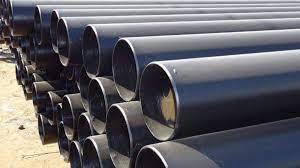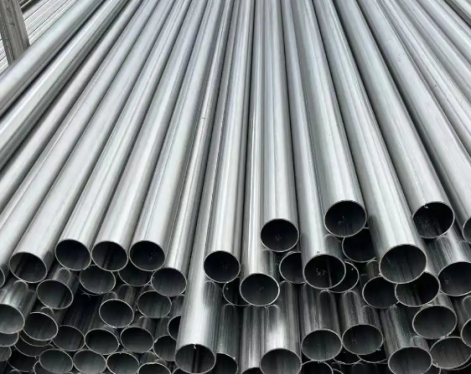Seamless pipe is a kind of steel pipe without welds, which is manufactured by hot processing methods such as perforation and hot rolling. When necessary, hot-processed tubes can be further cold-processed to the desired shape, size and properties. At present, seamless pipes are widely used in petrochemical production equipment. This article will briefly introduce the quenching process of carbon steel seamless pipes.
Definition of quenching
A heat treatment process in which the steel is heated to Ac3 or above Ac1, kept for a certain period of time, and then cooled at a speed greater than the critical quenching speed Vk to transform the supercooled austenite into martensite or bainite.
The structure is obtained by quenching steel: martensite or lower bainite, a small amount of retained austenite and an undissolved second phase.

The purpose of quenching is to transform the supercooled austenite into martensite or bainite to obtain a martensite or bainite structure, which is then combined with tempering at different temperatures to greatly improve the strength, hardness, and wear resistance of the steel. Properties, fatigue strength and toughness, etc., to meet the different use requirements of various mechanical parts and tools. Quenching can also be used to meet the special physical and chemical properties of certain special steels, such as ferromagnetism and corrosion resistance.
Problems and measures during the quenching process of carbon steel seamless pipes
1. Non-uniform quenching: Due to the difference in shape, structure and size of carbon steel seamless pipes, the hardness and strength after quenching may be unevenly distributed. The solution can be multiple quenchings, appropriate changes in the process parameters of the quenching medium, and reasonable heating and cooling speed control.
2. Cracks occur: Internal or surface cracks may occur in carbon steel seamless pipes due to the influence of temperature gradient during the quenching process. The solution could be to enhance the uniform heating and cooling process of the material, avoid rapid cooling and overheating, and perform appropriate tempering to eliminate internal stress.
3. Deformation or warping: The volume change of carbon steel seamless pipes due to temperature changes during the quenching process may cause deformation or warping of the material. The solution can be to use preheating treatment to reduce the temperature gradient; to perform tempering treatment after quenching to reduce the internal stress of the material.
4. High-temperature oxidation: In high-temperature environments, carbon steel seamless pipes may react with oxygen in the air to produce an oxide layer. The solution can be to use quenching under protective atmosphere or vacuum conditions to reduce the contact between the material and oxygen; pickling or electrolytic deoxidation is performed after quenching.
5. Selection of quenching medium: Different metal materials require the selection of appropriate quenching media. The solution can be to choose the appropriate quenching medium, such as water, oil or salt, according to the composition and requirements of the material.
In general, the problems that arise during the quenching process of carbon steel seamless pipes require reasonable setting of process parameters, selection of appropriate quenching media, and necessary heat treatment process control to obtain ideal material properties.
Definition of quenching
A heat treatment process in which the steel is heated to Ac3 or above Ac1, kept for a certain period of time, and then cooled at a speed greater than the critical quenching speed Vk to transform the supercooled austenite into martensite or bainite.
The structure is obtained by quenching steel: martensite or lower bainite, a small amount of retained austenite and an undissolved second phase.

The purpose of quenching is to transform the supercooled austenite into martensite or bainite to obtain a martensite or bainite structure, which is then combined with tempering at different temperatures to greatly improve the strength, hardness, and wear resistance of the steel. Properties, fatigue strength and toughness, etc., to meet the different use requirements of various mechanical parts and tools. Quenching can also be used to meet the special physical and chemical properties of certain special steels, such as ferromagnetism and corrosion resistance.
Problems and measures during the quenching process of carbon steel seamless pipes
1. Non-uniform quenching: Due to the difference in shape, structure and size of carbon steel seamless pipes, the hardness and strength after quenching may be unevenly distributed. The solution can be multiple quenchings, appropriate changes in the process parameters of the quenching medium, and reasonable heating and cooling speed control.
2. Cracks occur: Internal or surface cracks may occur in carbon steel seamless pipes due to the influence of temperature gradient during the quenching process. The solution could be to enhance the uniform heating and cooling process of the material, avoid rapid cooling and overheating, and perform appropriate tempering to eliminate internal stress.
3. Deformation or warping: The volume change of carbon steel seamless pipes due to temperature changes during the quenching process may cause deformation or warping of the material. The solution can be to use preheating treatment to reduce the temperature gradient; to perform tempering treatment after quenching to reduce the internal stress of the material.
4. High-temperature oxidation: In high-temperature environments, carbon steel seamless pipes may react with oxygen in the air to produce an oxide layer. The solution can be to use quenching under protective atmosphere or vacuum conditions to reduce the contact between the material and oxygen; pickling or electrolytic deoxidation is performed after quenching.
5. Selection of quenching medium: Different metal materials require the selection of appropriate quenching media. The solution can be to choose the appropriate quenching medium, such as water, oil or salt, according to the composition and requirements of the material.
In general, the problems that arise during the quenching process of carbon steel seamless pipes require reasonable setting of process parameters, selection of appropriate quenching media, and necessary heat treatment process control to obtain ideal material properties.









